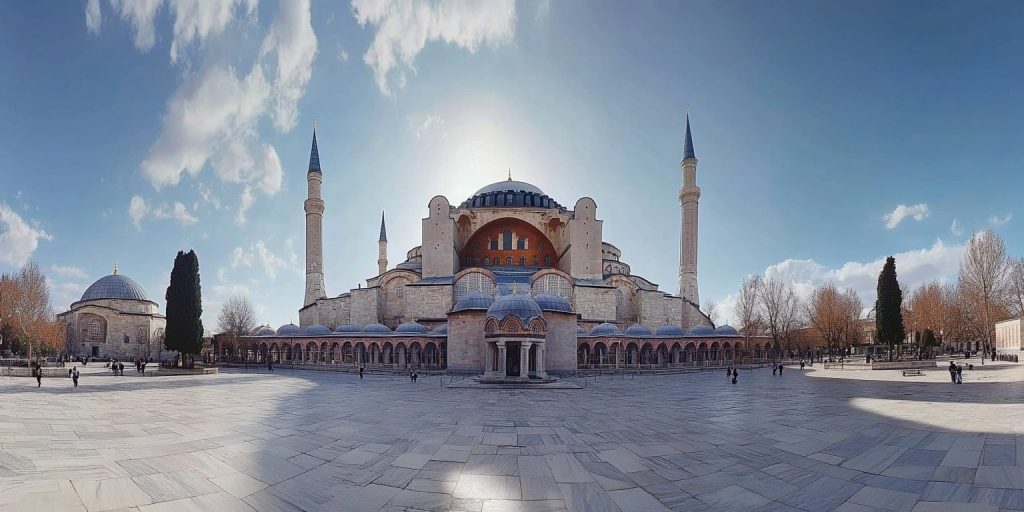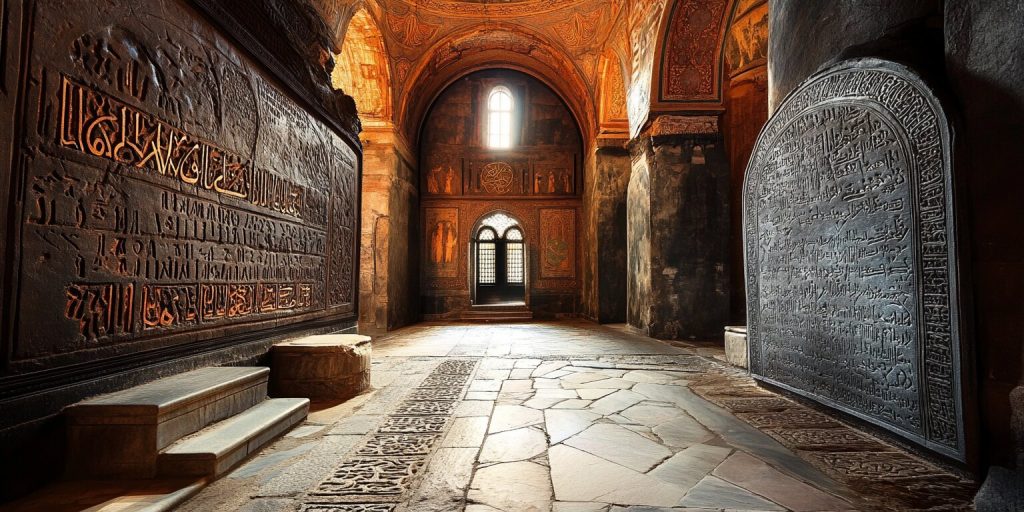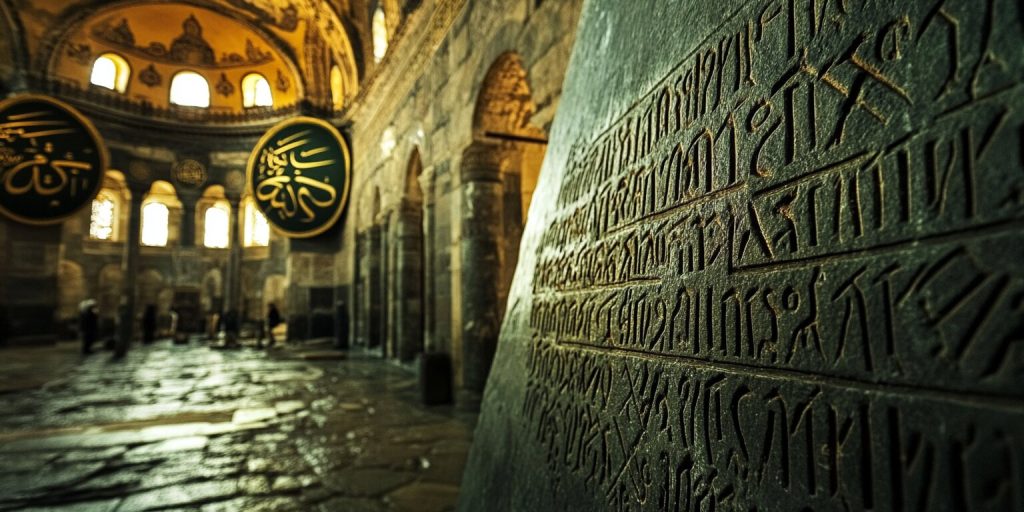Viking Heritage, Vikings
Where Is the Viking Graffiti on the Hagia Sophia?
The Viking graffiti is on Hagia Sophia’s marble parapets in the upper gallery. It shows how the Norse and Byzantine Empires were connected. Hagia Sophia was first a Christian basilica, then an imperial mosque, and now a museum that houses runic inscriptions in its marble.
This famous building in Istanbul, Turkey, has a long history tied to the Viking era. The Viking carvings inside show how Vikings reached Constantinople. They highlight the wide cultural connections of that time.
Introduction to Viking Graffiti in Hagia Sophia
Hagia Sophia was built in the 6th century. It has been a key place for religion, politics, and art in the Byzantine Empire. The building is famous for its Byzantine beauty and hidden secrets.
One of these secrets is the runic inscriptions inside. They show how the Norsemen and Byzantines connected during the Viking Age.
Historical Context of Hagia Sophia
Emperor Justinian I started building Hagia Sophia in 537 AD. It became the main church of Constantinople and, for many years, the heart of Eastern Orthodox Christianity.

Its stunning domes and mosaics have witnessed many important events. Hagia Sophia changed from a cathedral to a mosque and now is a museum that features runes carved by the Norsemen. It tells the story of its long history.
Norse Influence and Presence
In the 9th century, Norsemen, or Vikings, reached as far as Constantinople. They were warriors and traders who became part of the Varangian Guard. This group protected the Byzantine emperors.
It’s thought that some of these Varangians carved the runes in Hagia Sophia, which may have been discovered in Iceland. These inscriptions from the Viking Age show how the Norsemen and Byzantines met. It’s a story of two cultures coming together in a grand place.
The Discovery of Viking Graffiti in Hagia Sophia
The finding of Viking graffiti in Hagia Sophia has amazed historians and archaeologists. It shows us that Norse explorers were in Byzantine lands.
Who Discovered the Graffiti?
The person who first saw the Viking graffiti in Hagia Sophia is not known for sure. But, it was likely archaeologists and scholars who loved Norse history and the Byzantine Empire. Names like Halfdan and Are are often mentioned in studies about this find, even though we don’t know all the details.
Date of Discovery
There is much discussion about when the runic graffiti was found, especially in relation to the Howe burial chambers. Some think it was in the 1960s, but we’re not really sure when it was first seen and recorded.
Location within Hagia Sophia
The Hagia Sophia Viking graffiti is found in special spots inside the grand Hagia Sophia, mainly on the northern and western sides of the upper gallery. These historical Norse carvings show how Viking and Byzantine cultures mixed.
Exact Spot of the Graffiti
The graffiti is in the upper gallery. This spot was easy for many people to see when Hagia Sophia was a church and then a mosque. The graffiti tells us about the Viking presence in Byzantium, their travels, and how they blended with other cultures.
The Details of the Viking Graffiti Hagia Sophia
The Viking graffiti in Hagia Sophia shows deep links between the Norsemen and the Byzantine Empire. These Runic inscriptions, which use the Younger Futhark alphabet, show how far the Vikings reached beyond their Scandinavian homes.

Inscription and Interpretation
Names like ‘Halvdan’ and ‘Aré’ are common in Viking graffiti. The graffiti was carefully made. It shows the bravery of the Varangian Guard, Norse warriors in the Byzantine army who may have engraved their stories in Hagia Sophia.
The runes are simple and direct. They let us peek into the lives of these Norsemen.
Significance of the Graffito
The Viking graffiti in Hagia Sophia is more than just interesting. It shows how far the Norsemen traveled and their habit of leaving marks, similar to the Maeshowe tomb in Orkney, Scotland, with its runic inscriptions.
Comparison with Other Norse Inscriptions
Compared to other Norse inscriptions, the Hagia Sophia graffiti is unique. It shows how Viking culture mixed with other regions. Like Hagia Sophia’s marble, graffiti in Scotland also shows Viking influence and connections.
Viking Graffiti’s Artistic and Cultural Value
The Viking graffiti in Hagia Sophia shows how art and culture mixed in the Viking Age. These marks inside the famous Byzantine cathedral tell us more than just stories. They show a special meeting of the Norsemen and people of medieval Constantinople.
These carvings are very important for history. They tell us about Viking travels and how they met other cultures. The graffiti in Hagia Sophia is a key example of Viking art, similar to the Viking graffiti in Scotland. It shows how Vikings traded, fought, and also made their mark through art.
Looking at the graffiti, we see how Vikings expressed themselves artistically, especially through the runic inscriptions in Hagia Sophia’s marble. Each writing tells us about the person who made it, giving us a closer look at Viking life. Plus, it shows how Constantinople was a place where different cultures mixed, much like the interactions seen in the Maes Howe burial chamber.
In short, the Viking graffiti in Hagia Sophia shows a big cultural mix. These inscriptions are more than old artifacts. They prove the Vikings’ lasting impact and their skill in leaving art behind, particularly through the runic inscriptions in Hagia Sophia’s marble. Studying this graffiti helps us understand the Viking Age better and the connections between cultures back then.
Conclusion
The Hagia Sophia Viking graffiti shows the wide reach of Viking explorers and the mix of cultures in the Byzantine Empire. These carvings are a special link to the Viking Age.
They show how Vikings moved far from their homes into what is now Turkey. These marks on the wall are more than just graffiti. They are a peek into a time when the world was more connected.
These carvings tell us about the rich cultural exchanges before our globalized world. They show us how different people lived and interacted.
Keeping these carvings safe is important. It’s about keeping alive the stories of the Viking Age. By studying them, we learn more about the Vikings and their world. This helps us understand their connections with other cultures, especially in the Byzantine Empire.

